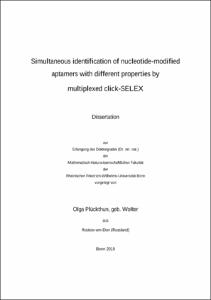Plückthun, Olga: Simultaneous identification of nucleotide-modified aptamers with different properties by multiplexed click-SELEX. - Bonn, 2020. - Dissertation, Rheinische Friedrich-Wilhelms-Universität Bonn.
Online-Ausgabe in bonndoc: https://nbn-resolving.org/urn:nbn:de:hbz:5-58830
Online-Ausgabe in bonndoc: https://nbn-resolving.org/urn:nbn:de:hbz:5-58830
@phdthesis{handle:20.500.11811/8412,
urn: https://nbn-resolving.org/urn:nbn:de:hbz:5-58830,
author = {{Olga Plückthun}},
title = {Simultaneous identification of nucleotide-modified aptamers with different properties by multiplexed click-SELEX},
school = {Rheinische Friedrich-Wilhelms-Universität Bonn},
year = 2020,
month = jun,
note = {Voltage-gated sodium channels (VGSC) are important key regulators in excitable tissue that initiate and propagate the action potential in specifically excitable tissue such as brain nerves or muscle. In order to understand the impact of VGSC on the complex nerve system, specific molecular tools are required that enable the spatial-temporal control of VGSC function. These tools shall recognize and modulate VGSC with high affinity and utmost specificity.
Aptamers are short oligo(deoxy)nucleotides that are able to interact with target molecules in a highly affine and specific way. Aptamers are identified by an in vitro selection procedure known as SELEX (Systematic Evolution of Ligands by EXponential enrichment).
The present study investigated whether the SELEX methods allow the generation of aptamers targeting voltage-gated sodium channels. Several selection methods such as cell-SELEX, click-SELEX, or SELEX targeting small peptides were investigated using the different subtypes of VGSC (Nav1.1, Nav1.2, Nav1.4, Nav1.5, Nav1.6). All selections led to an enrichment of aptamers targeting the VGSC-presenting HEK293 cells or the peptide immobilization matrix, but not VGSC or VGSC-peptides. One possible cause might be the limited chemical diversity in the subjected library. Click-SELEX, which uses copper(I)-catalyzed alkyne–azide cycloaddition (CuAAC) for DNA functionalization, promises a higher chemical diversity in the library compared to DNA libraries, but allows only one modification per library. The present study established a multiplexed click-SELEX approach. This unique method allows the selection of clickmers from several libraries containing different modifications in one procedure, e.g., by using five different azides for DNA functionalization.
The multiplexed click-SELEX method has been validated in two selections targeting two different proteins, Cycle 3 Green Fluorescent Protein (C3-GFP) and streptavidin. Both selections led to the generation of highly affine and specific clickmers with slow dissociation (koff rate). The clickmers depend on the correct functionalization for interaction with the protein.
Now that multiplexing of modified nucleobases has been established in a SELEX, the procedure in this proof of concept study can be applied to a variety of other targets. The simple applicability of the multiplexed click-SELEX approach will benefit all in vitro selection methods and allow the generation of clickmers targeting “difficult” target molecules such as VGSC.},
url = {https://hdl.handle.net/20.500.11811/8412}
}
urn: https://nbn-resolving.org/urn:nbn:de:hbz:5-58830,
author = {{Olga Plückthun}},
title = {Simultaneous identification of nucleotide-modified aptamers with different properties by multiplexed click-SELEX},
school = {Rheinische Friedrich-Wilhelms-Universität Bonn},
year = 2020,
month = jun,
note = {Voltage-gated sodium channels (VGSC) are important key regulators in excitable tissue that initiate and propagate the action potential in specifically excitable tissue such as brain nerves or muscle. In order to understand the impact of VGSC on the complex nerve system, specific molecular tools are required that enable the spatial-temporal control of VGSC function. These tools shall recognize and modulate VGSC with high affinity and utmost specificity.
Aptamers are short oligo(deoxy)nucleotides that are able to interact with target molecules in a highly affine and specific way. Aptamers are identified by an in vitro selection procedure known as SELEX (Systematic Evolution of Ligands by EXponential enrichment).
The present study investigated whether the SELEX methods allow the generation of aptamers targeting voltage-gated sodium channels. Several selection methods such as cell-SELEX, click-SELEX, or SELEX targeting small peptides were investigated using the different subtypes of VGSC (Nav1.1, Nav1.2, Nav1.4, Nav1.5, Nav1.6). All selections led to an enrichment of aptamers targeting the VGSC-presenting HEK293 cells or the peptide immobilization matrix, but not VGSC or VGSC-peptides. One possible cause might be the limited chemical diversity in the subjected library. Click-SELEX, which uses copper(I)-catalyzed alkyne–azide cycloaddition (CuAAC) for DNA functionalization, promises a higher chemical diversity in the library compared to DNA libraries, but allows only one modification per library. The present study established a multiplexed click-SELEX approach. This unique method allows the selection of clickmers from several libraries containing different modifications in one procedure, e.g., by using five different azides for DNA functionalization.
The multiplexed click-SELEX method has been validated in two selections targeting two different proteins, Cycle 3 Green Fluorescent Protein (C3-GFP) and streptavidin. Both selections led to the generation of highly affine and specific clickmers with slow dissociation (koff rate). The clickmers depend on the correct functionalization for interaction with the protein.
Now that multiplexing of modified nucleobases has been established in a SELEX, the procedure in this proof of concept study can be applied to a variety of other targets. The simple applicability of the multiplexed click-SELEX approach will benefit all in vitro selection methods and allow the generation of clickmers targeting “difficult” target molecules such as VGSC.},
url = {https://hdl.handle.net/20.500.11811/8412}
}






